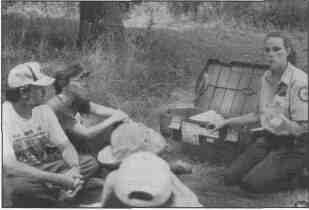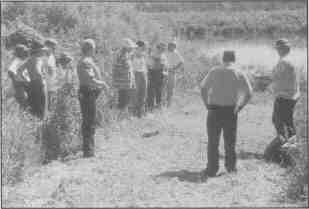PARTNERSHIPS
PARK DISTRICTS, FOREST PRESERVES AND RECREATION DEPARTMENTS
WORKING TOGETHER WITH CIVIC AND BUSINESS LEADERS TO BUILD OUR COMMUNITIES
Teaching] A to Z in Environmental Education
From amphibians to zooplankton, K-12 teachers from Champaign County
learned how to teach the environment, thanks to a four-way partnership
BY EARL CREUTZBURG AND KRISTINA DUPPS

K-12 teachers from the Champaign area spent Two days "in the field," learning about environmental education as part of a partnership between the Champaign County Forest Preserve District, Parkland College, the Champaign/Ford Counties Regional Office of Education and Earth Partners.
It's really not a new idea for a park district or forest preserve to sponsor an
environmental education workshop for K-12 teachers. It is novel, however, to coordinate such an effort among four separate agenciesa
college, a county-wide office of education, a farm bureau and a forest
preserve district. Plus, include
training on the Internet, requiring access to a large number of
computer terminals.
Yet this unlikely combination
of outdoor experiences and Internet training proved to be very
complementary, educating 34
teachers from Champaign
County in such varied experiences as collecting insects to accessing prairie information from
the Internet.
The four partner agencies included Parkland College, the
Champaign/Ford Counties Regional Office of Education,
Earth Partners (an agency of the
Farm Bureau), and the
Champaign County Forest
Preserve District (CCFPD).
Held in late -June of 1998, the
workshop was funded through
a Dwight D. Elsenhower Professional Development Grant for $30,000
from the Illinois Board of Higher Education and was tided "Integrating
Internet and Hands-on Training: Using Local Field Sites and Our Ecosystem to Transform Science Education." The objective of the workshop was
to teach teachers how to incorporate technology and hands-on field experiences into their science curriculum using the Internet, computer-aided image technology, morion video, as well as wetlands, woodland and other
natural settings.
A demonstrated local need for the combined computer and outdoor
training for teachers came from
a survey of local classroom
teachers commissioned by the
CCFPD in March of 1997
and conducted by the University of Illinois (see reference
footnote on page 13). The
survey found that 85 percent
of the 221 respondents had
no previous training in environmental education and that
85 percent had never utilized
the natural areas of the CCFPD
for class purposes.
The most common reason
given for not using the natural
environment was the lack of
familiarity of possible uses. Additionally, the survey indicated
a tremendous demand for environmental education training, classroom science kits and
other instructional supplies,
and Internet access for up-to-the-minute information pertaining to the
environment.
Ultimately, the four-day workshop included:
field experiences with activities in prairie, wetland, grassland, woodland, river, savanna and marsh ecosystems;
March/April 1 999 ¦ 11
PARTNERSHIPS

Among their field experiences/ teachers observe amphibians and reptiles near water's edge and identified birds in the waterfowl management area.
instruction on the Internet and available software,
held at the Parkland College Computer Lab;
instruction and tour of the Illinois Natural History
Biodiversity display with teaching manual;
CDs, videotapes, maps and posters;
ecosystem/biodiversity resource kit;
activity guide for sites in the CCFPD;
environmental education manuals;
Illinois Landcover Adas with CD, map, and poster of Illinois;
Leopold Environmental Education Manual,
literature book and video; and
a stipend of $200.
Certainly one of the unique features of the program was the great
amount of hands-on experiences provided to the participants. One entire
day was devoted to exploring the Internet and several software programs
containing environmental programs. This was followed by two days in
the field where the teachers gathered water samples to study aquatic life,
observed amphibians and reptiles near water's edge, identified birds in
the waterfowl management area, learned animal tracking techniques, and
located common and rare plants in the prairie and forest areas.
Microscopes, binoculars, and magnifying glasses were made available
in order to provide a closer look at the many organisms ranging from
zooplankton to Great Blue Herons. All activities were conducted with the
specific goal of how each activity could be used with a school group to
teach a specific environmental concept such as predation, food webs and
symbiosis. The final day of the workshop required teachers to become
students as they entered the classroom to hear guest speakers from University of Illinois and the Illinois Natural History Survey present
information about research and practical methods in conducting environmental
education.
To conclude the workshop, teachers were provided additional time on
the computers to further explore Internet sites and evaluate computer
software they would be given as part of their instructional kits. These
instructional kits, worth approximately $325, were given to each teacher
and contained laboratory supplies, posters, identification guides, activity
packets, computer software, extensive lists of web sites, a video, slides,
numerous books and magazines, workbooks and other instructional
guides. It was the intent of the workshop that these kits were to be used by
the participating teachers at their home schools to provide in-service
training to the colleagues of these participants. The Forest Preserve District
Environmental Education staff and Earth Partners staff would provide
ongoing support to these teachers throughout the following school year.
The 34 teachers completing the workshop have provided in-service
training to another 54 teachers. When all of these teachers incorporate
features from their workshop into their classes, they will have affected
more than 3,100 students from kindergarten through 12th grade in 22
different schools!
At the end of the workshop the teachers were asked to provide a detailed evaluation of the week's activities. Perhaps the two questions which
were most telling on the usefulness of the workshop were these:
Do you feel that you will incorporate the Internet and computer resources into your classroom activities?
Do you feel that you will incorporate field activities into your classroom?
The response to both questions was 34 "yes" and 0 "no." Some of the
teachers' comments were:
"The information is very relevant to the needs of our students and the world
today."
"...a. very practical and useful investment of time and money."
"I didn't realize that Champaign County had so many great resources and
talented people."
"Excellent...highly recommended to all disciplines, not just science teachers."
"/ was delighted and impressed with the cooperation of all partners involved. "
Because of the cooperation of all partners, the workshop was a success.
But the four agencies were in turn dependent on several other agencies
which each provided a piece of the workshop program. These agencies
included:
University of Illinois
Pheasants Forever
Grand Prairie Friends
Illinois Department of Natural Resources
Illinois Natural History Survey
12 ¦ Illinois Parks and Recreation
TEACHING A TO Z IN ENVIRONMENTAL EDUCATION
Illinois State Geological Survey
Missouri Department of Conservation
The Nature Conservancy
University of Illinois Cooperative Extension Service
This was no doubt a unique experience for all these groups, working
together for the common goal of providing local teachers a professional
development experience that would help them bring students in closer
contact with the natural world.
By working together, the Champaign County Forest Preserve District,
Parkland College, Earth Partners and the local Regional Office of
Education were able to provide a highly successful environmental
education workshop to 34 local teachers. The response of the teachers to the four-day workshop was
overwhelming approval and encouragement to the
organizers to repeat the offering in the following year.
Those teachers previously unable to attend because
of group size limitations would be able to participate
in future workshops. Even more good news: the
"partners" received another grant from the Dwight
D. Elsenhower foundation to repeat the workshop
and build on the experiences of last summer!
Reference
Smith-Sebasto, Nicholas, assistant professor, Department of Natural Resources and Environmental Sciences, UIUC, "Environmental Education and the Champaign County Forest Preverve District: An Exploration of the Needs and Perceptions of Champaign County In-Service K-12 Public School Teachers, "March, 1997.
Acknowledgments
For drafting the Elsenhower Grant and working together in the administration of the program, our utmost
appreciation to Anita Broeren, director or development, Poland College: Roger Kirkwood, director or natural
resources, Champaign County Fores! Preserve District and, Robbie Berg, Forth Fanners, Champaign County
Farm Bureau. Thanks also to Parkland College instructors Heidi Lousier and Wendy Grethen tor providing
much of the field activities and computer experiences. Our appreciation to many, many others not specifically
mentioned who also hod a role in last summer's success, we thank each and every one. And! last but not least,
thanks to the participants, who have encouraged alt or us to try another workshop.
EARl CREUTZBURG
is professor of Biology at Parkland College in Champaign and a commissioner
for the Champaign County Forest Preserve District.
KRISTINA DUPPS
is coordinator of environmental education at the Champaign County Forest
Preserve District.
The Champaign County Forest Preserve District received an Outstanding
Program Award for "Getting Your Feet Wet, Teaching in the Environment' from
the Illinois Park and Recreation Association at the IAPD/IPRA Annual
Conference in Chicago this past January.
Benefits of the Partnership
The 34 teachers who completed this
environmental education workshop
have provided in-service training to
another 54 teachers.
When all of these teachers incorporate features from their workshop into
their classes, they will have affected
more than 3,100 students from kindergarten through 12th grade in 22
different schools!
|
March/April 1999 13

